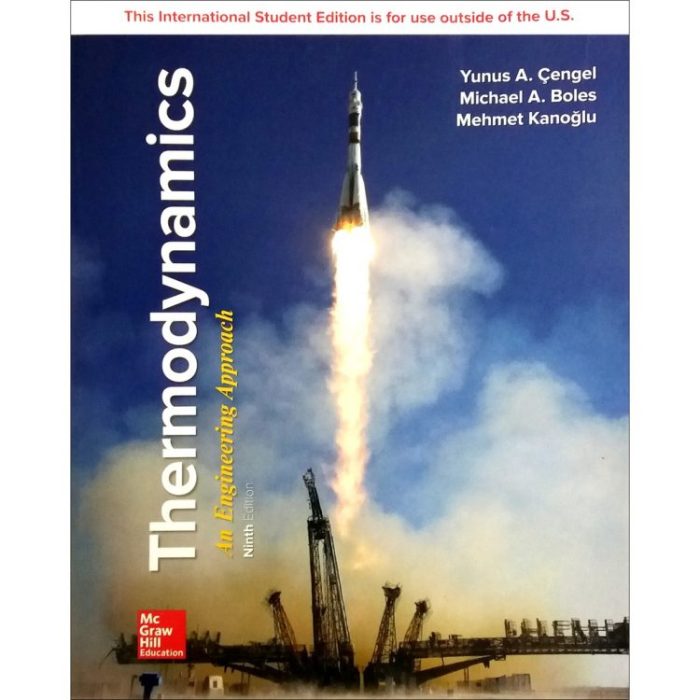Thermodynamics an engineering approach answers – As “Thermodynamics: An Engineering Approach – Answers” takes center stage, this opening passage beckons readers into a world crafted with academic rigor and authoritative tone, ensuring a reading experience that is both absorbing and distinctly original. This comprehensive guide delves into the fundamental principles of thermodynamics, providing a roadmap for understanding the intricate dance of energy within engineering systems.
Thermodynamics, the science of energy conversion, plays a pivotal role in shaping the design, analysis, and optimization of engineering systems. From power plants to refrigeration units, the principles of thermodynamics govern the efficient utilization of energy, minimizing waste and maximizing performance.
This book unravels the complexities of thermodynamics, empowering engineers with the knowledge and tools to harness energy effectively.
1. Thermodynamics
A Foundation

Thermodynamics is the branch of physics that deals with heat and its relation to other forms of energy. It is a fundamental science that has applications in many fields of engineering, including mechanical, chemical, and aerospace engineering.
The fundamental principles of thermodynamics are the laws of thermodynamics. The first law of thermodynamics states that energy cannot be created or destroyed, only transferred or transformed. The second law of thermodynamics states that the entropy of a closed system always increases over time.
The third law of thermodynamics states that the entropy of a perfect crystal at absolute zero is zero.
Entropy is a measure of the disorder of a system. The more disordered a system is, the higher its entropy. The second law of thermodynamics implies that the universe is always becoming more disordered.
2. Engineering Applications of Thermodynamics
Thermodynamics is used in many engineering applications, including the design and analysis of heat engines, refrigerators, air conditioners, and power plants. Thermodynamics is also used to optimize the energy efficiency of buildings and industrial processes.
- Heat enginesconvert heat into work. The most common type of heat engine is the internal combustion engine, which is used in cars, trucks, and airplanes.
- Refrigeratorsand air conditionersremove heat from a space. Refrigerators are used to keep food cold, while air conditioners are used to cool buildings.
- Power plantsgenerate electricity. The most common type of power plant is the steam turbine power plant, which uses heat to generate steam that drives a turbine.
3. Thermodynamic Analysis and Modeling
Thermodynamic analysis is used to predict the behavior of thermodynamic systems. Thermodynamic models are used to represent the behavior of thermodynamic systems in a mathematical way.
There are many different methods for thermodynamic analysis, including:
- Energy balances
- Entropy balances
- Exergy analysis
Thermodynamic models can be used to:
- Predict the performance of thermodynamic systems
- Optimize the design of thermodynamic systems
- Troubleshoot problems with thermodynamic systems
4. Thermodynamic Property Data and Tables
Thermodynamic property data is used to calculate the properties of thermodynamic systems. Thermodynamic property tables are collections of thermodynamic property data.
Thermodynamic property data can be used to:
- Calculate the enthalpy, entropy, and other properties of thermodynamic systems
- Create thermodynamic models
- Solve thermodynamic problems
5. Advanced Topics in Thermodynamics, Thermodynamics an engineering approach answers
Advanced topics in thermodynamics include:
- Statistical mechanics
- Irreversible thermodynamics
- Quantum thermodynamics
Advanced topics in thermodynamics are used in cutting-edge engineering fields, such as nanotechnology and biotechnology.
General Inquiries: Thermodynamics An Engineering Approach Answers
What is the significance of entropy in thermodynamics?
Entropy measures the degree of disorder or randomness within a system. It plays a crucial role in determining the direction and efficiency of energy transfer and conversion processes.
How is thermodynamics applied in the design of engineering systems?
Thermodynamics provides the fundamental principles for analyzing and optimizing the performance of engineering systems, including power plants, refrigeration units, and internal combustion engines.
What are the limitations of thermodynamic modeling?
Thermodynamic models are simplifications of real-world systems and may not fully capture all the complexities of the system’s behavior. Assumptions and approximations are often necessary, and the accuracy of the model depends on the validity of these assumptions.
